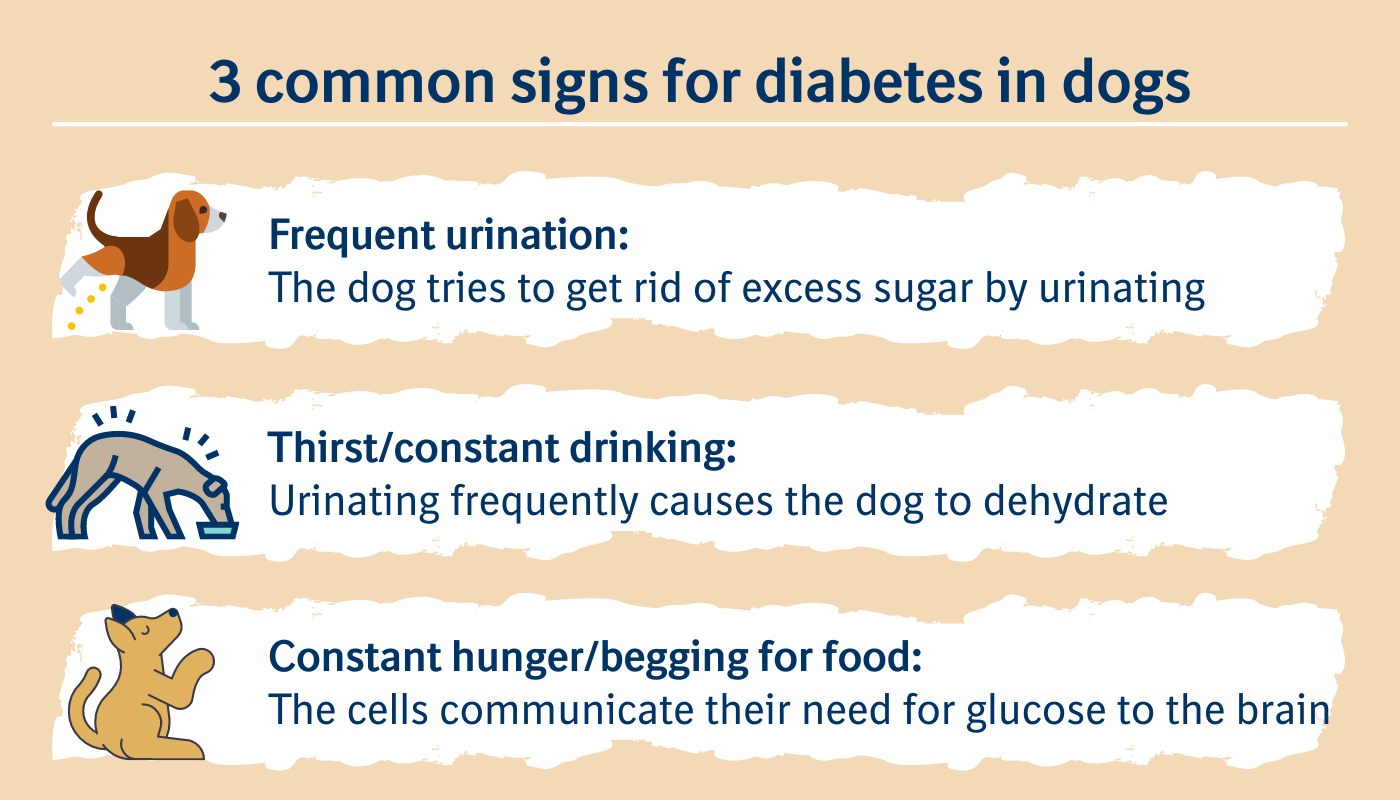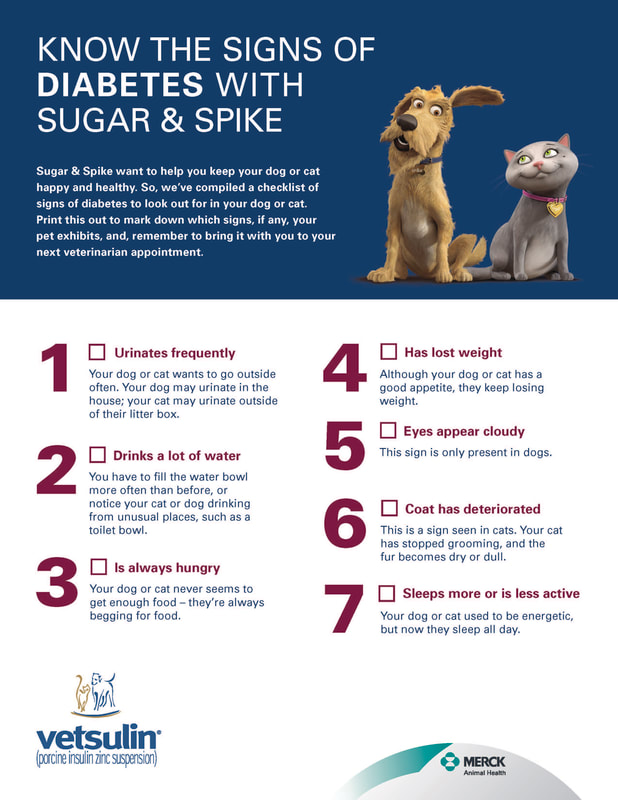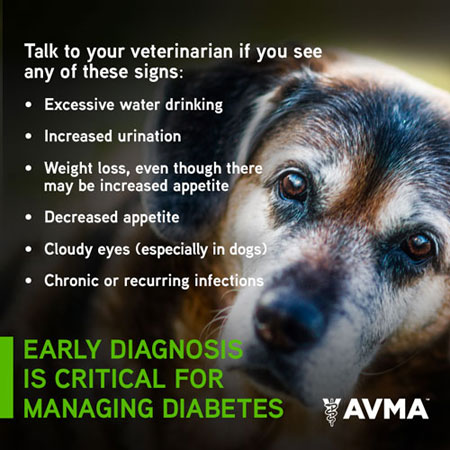Early signs of diabetes in a dog include increased thirst and urination, sudden weight loss, and changes in appetite. Other symptoms can include lethargy, urinary tract infections, and vision problems.
A dog with diabetes may also have a sweet, fruity odor to their breath. Diabetes, if left untreated, can lead to more serious complications, so it’s important to recognize these signs and seek veterinary care promptly. If you notice any of these symptoms in your dog, it’s best to consult a veterinarian for a proper diagnosis and treatment plan.
By understanding the signs of diabetes in dogs, pet owners can take proactive steps to ensure their furry friends’ health and well-being. Helping them live long, happy, and healthy lives.
Recognizing Diabetes In Dogs
If you’re a dog owner, it’s important to be aware of the signs and symptoms of diabetes in dogs. Diabetes is a chronic metabolic disorder that affects dogs of all breeds and sizes, and early detection is key to managing the condition effectively. By recognizing the common symptoms and physical signs associated with dog diabetes, you can seek prompt veterinary care and improve your furry friend’s quality of life.
Common Symptoms Of Dog Diabetes
When it comes to recognizing diabetes in dogs, it’s crucial to be aware of the common symptoms. Here are some indicators that your dog may be suffering from this condition:
- Increased thirst and urination:
- Weight loss despite an increased appetite:
- Lethargy and lack of energy:
- Cloudy eyes:
- Recurring infections:
If you notice these symptoms in your dog, it’s important to consult with your veterinarian to determine if diabetes could be the underlying cause.
Physical Signs To Look Out For
Aside from the common symptoms mentioned above, there are physical signs that you can look out for to help with the diagnosis of diabetes in your dog:
| Physical Sign | Explanation |
|---|---|
| Thin or malnourished appearance | Diabetic dogs may exhibit weight loss or a noticeable decrease in body condition even with a healthy appetite. |
| Excessive panting | Dogs with diabetes may pant more frequently or heavily due to increased blood glucose levels. |
| Unexplained dehydration | Excessive drinking and urination can lead to dehydration, which may be visible as dry gums or sunken eyes. |
| Sweet-smelling breath | Diabetic dogs may have breath that smells fruity or sweet due to the presence of ketones. |
By being vigilant and paying close attention to any changes in your dog’s behavior, appetite, or physical appearance, you can better recognize the signs of diabetes and provide early intervention to prevent further complications.

Credit: www.boehringer-ingelheim.com
Diagnosing Diabetes In Dogs
Diagnosing diabetes in dogs can be challenging, as the symptoms may not always be immediately obvious. However, early detection is crucial to ensure your pet receives the necessary care and support. By being aware of the signs and seeking timely veterinary assistance, you can help manage your dog’s condition effectively. A prompt diagnosis is essential for establishing a treatment plan tailored to your dog’s specific needs.
Diagnostic Tests For Canine Diabetes
Detecting diabetes in dogs often involves a series of diagnostic tests to confirm the presence of the condition. These tests may include:
- Blood tests to measure glucose levels
- Urinalysis to check for high levels of glucose in the urine
- Fructosamine tests to assess the average glucose levels over a few weeks
- Glycosylated hemoglobin tests to determine the average glucose levels over a longer period
Importance Of Early Detection
Early detection of diabetes in dogs is vital for effectively managing the condition and preventing potential complications. Timely diagnosis allows for the implementation of appropriate dietary changes, medication, and lifestyle modifications to improve the dog’s quality of life. Additionally, early intervention can help minimize the risk of secondary health issues associated with diabetes, such as kidney disease and vision problems.
Managing Diabetes In Dogs
Dietary Changes For Diabetic Dogs
To manage diabetes in dogs, dietary changes are essential. A low-carbohydrate, high-fiber diet is recommended to help control blood sugar levels. The diet should consist of lean proteins, vegetables, and complex carbohydrates to ensure a balanced intake of nutrients.
Insulin Therapy And Monitoring
Insulin therapy is a crucial aspect of managing diabetes in dogs. It involves administering insulin injections as prescribed by the veterinarian. Regular blood glucose monitoring is necessary to ensure the insulin dosage is sufficient and to detect any fluctuations in blood sugar levels.
Exercise And Weight Management
Regular exercise is important for diabetic dogs to help regulate blood sugar levels and maintain a healthy weight. Weight management is essential to prevent obesity, which can worsen diabetes. It’s important to engage in moderate physical activity and monitor the dog’s weight regularly.

Credit: www.facebook.com
Preventing Complications
Recognizing the signs of diabetes in a dog is crucial in preventing complications. Look out for frequent urination, increased thirst, weight loss, and lethargy as potential indicators. Early detection can help manage the condition effectively and improve your dog’s overall health.
Blood Sugar Regulation
One of the most crucial aspects of preventing complications in dogs with diabetes is blood sugar regulation. Consistently monitoring and controlling your dog’s blood sugar levels can help minimize the risk of serious health issues. The primary goal is to keep the blood sugar within a target range, as recommended by your veterinarian. This can be achieved through a combination of a balanced diet, regular exercise, and medication, if necessary. It’s essential to work closely with your vet to develop a customized plan that suits your dog’s specific needs.
Regular Veterinary Check-ups
Regular veterinary check-ups are a critical component of preventing complications in diabetic dogs. It’s important to schedule routine visits to monitor your dog’s condition and make any necessary adjustments to their treatment plan. During these check-ups, your vet will conduct thorough physical examinations, assess the blood sugar levels, and may perform additional tests, such as bloodwork and urinalysis. By staying proactive and addressing any potential issues promptly, you can ensure that your dog’s diabetes is properly managed, reducing the risk of complications.
Educating Yourself For Better Care
Another key factor in preventing complications in diabetic dogs is educating yourself about the condition and its management. Learning about the signs and symptoms of diabetes, as well as the potential risks and complications, empowers you to provide better care for your furry friend. Stay informed about the proper administration of medications, the importance of diet and exercise, and potential warning signs that require immediate veterinary attention. By continually educating yourself, you can take proactive steps to prevent complications and provide the best possible care for your diabetic dog.
Living With A Diabetic Dog
Living with a diabetic dog requires dedication and a well-structured routine. It can be overwhelming at first, but creating a routine, seeking support and resources, and coping with the emotional impact can make the journey easier for both you and your furry friend. Here, we’ll explore these aspects in detail.
Creating A Routine
Creating a routine is crucial when it comes to managing a diabetic dog’s health. Dogs thrive on predictability and structure. By establishing a consistent schedule for meals, walks, and insulin injections, you can help regulate their blood sugar levels effectively. Here are some tips for creating a routine:
- Set fixed meal times and feed your dog the same amount of food each day.
- Create a designated area where your dog receives their insulin injections.
- Stick to a consistent exercise routine, ensuring it aligns with their meal and insulin schedule.
- Monitor your dog’s water intake to ensure they stay hydrated throughout the day.
Support And Resources For Dog Owners
As a dog owner, you don’t have to face this journey alone. There are numerous support networks and resources available to help you navigate life with a diabetic dog. Here are some ways to seek support:
- Join online forums and communities dedicated to diabetic dog care, where you can connect with fellow dog owners facing similar challenges.
- Consult with your veterinarian regularly and ask for their guidance and recommendations.
- Consider participating in local support groups or meetups to gain insights and share experiences with others in your area.
- Educate yourself through reputable websites, books, and articles that provide valuable information on managing diabetes in dogs.
Coping With The Emotional Impact
Caring for a diabetic dog can be emotionally challenging. It’s important to acknowledge and address the emotional impact this journey may have on you. Here are some strategies to help cope with your emotions:
- Reach out to friends, family, or therapists for emotional support.
- Engage in stress-relieving activities such as yoga, meditation, or walks in nature.
- Journal your thoughts and feelings to process them effectively.
- Stay positive and celebrate small victories along the way; managing diabetes in dogs requires patience and perseverance.

Credit: www.internalmedicineforpetparents.com
Frequently Asked Questions Of What Are The Signs Of Diabetes In A Dog
What Are The Common Signs Of Diabetes In A Dog?
The common signs of diabetes in a dog include increased thirst, frequent urination, sudden weight loss, increased hunger, and lethargy. It’s important to look out for these signs and consult a veterinarian for proper diagnosis and treatment.
How Can I Detect Diabetes In My Dog Early?
Early detection of diabetes in dogs can be done by monitoring their water intake, urine output, and appetite. If you notice any significant changes in these areas, it’s recommended to schedule a veterinary visit for proper diagnosis and early intervention if necessary.
Can Diabetes In Dogs Be Treated?
Yes, diabetes in dogs can be managed and treated, but it is a lifelong condition. Treatment usually involves insulin injections, dietary changes, regular exercise, and close monitoring of blood glucose levels. It is crucial to work closely with a veterinarian to determine the best treatment plan for your dog’s specific needs.
Conclusion
Being aware of the signs of diabetes in your dog is crucial for their overall health and well-being. By paying attention to symptoms such as increased thirst, frequent urination, sudden weight loss, and changes in appetite, you can detect diabetes early and seek veterinary care.
Remember to monitor your dog’s behavior and consult with a professional to ensure their longevity and happiness. Stay vigilant and prioritize your furry friend’s health today!



